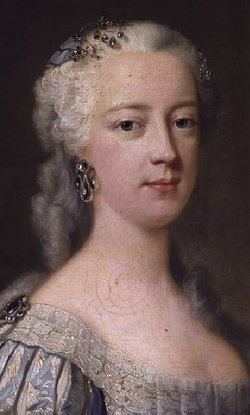Father George II Name Princess of | ||
 | ||
Parents George II of Great Britain, Caroline of Ansbach Grandparents George I of Great Britain, Sophia Dorothea of Celle Cousins Frederick the Great, Louisa Ulrika of Prussia, Prince Henry of Prussia, Princess Anna Amalia of, Wilhelmine of Prussia - Margravi Similar People George II of Great Britain, Caroline of Ansbach, Anne - Princess Royal an, Frederick - Prince of Wales, Prince William - Duke of C | ||
Hrh princess amelia of great britain 1783 1810
Princess Amelia of Great Britain (Amelia Sophia Eleanor; 10 June 1711 (New Style) – 31 October 1786) was the second daughter of George II of Great Britain.
Contents
Early life
Princess Amelia was born at Herrenhausen Palace, Hanover, Germany, on 30 May 1711 (Old Style). Her father was The Hereditary Prince of Brunswick-Luneburg, the son of the Elector of Hanover. Her mother was Caroline of Ansbach, daughter of Johann Friedrich, Margrave of Brandenburg-Ansbach. At her birth she was styled HSH Princess Amelia of Hanover. She was known to her family as Emily.
Great Britain
Under the Act of Settlement 1701, Princess Amelia's grandfather became King of Great Britain on 1 August 1714 following the death of Queen Anne. Amelia's father became Duke of Cornwall, and was created Prince of Wales on 27 September 1714. Amelia became HRH Princess Amelia. She moved to Great Britain with her family and resided at St James's Palace in London.
She was a sickly child, but was comparatively healthy as an adult. In 1722, her mother, who had progressive ideas, had Amelia and her sister Caroline inoculated against smallpox by an early type of immunisation known as variolation, which had been brought to England from Constantinople by Lady Mary Wortley Montagu and Charles Maitland. On 11 June 1727, George I died and her father succeeded him as George II. Amelia was now styled HRH The Princess Amelia. She lived with her father until his death in 1760.
Her aunt Sophia Dorothea, Queen in Prussia, suggested Amelia as a suitable wife for her son Frederick, Crown Prince of Prussia, but his father Frederick William I of Prussia forced him to marry Elisabeth Christine of Brunswick-Bevern instead. Amelia may have been the mother of composer Samuel Arnold (1740–1802) through an affair with a commoner of the name Thomas Arnold.
Amelia greatly enjoyed riding and hunting. She was disliked by artistic fops such as John, Lord Hervey, and Lady Pomfret considered her "one of the oddest princesses that ever was known; she has ears shut to flattery and her heart open to honesty."
Later life
In 1751, Princess Amelia became ranger of Richmond Park after the death of Robert Walpole. Immediately afterwards, the Princess caused major public uproar by closing the park to the public, only allowing few close friends and those with special permits to enter.
This continued until 1758, when a local brewer, John Lewis, took the gatekeeper, who stopped him from entering the park, to court. The court ruled in favour of Lewis, citing the fact that, when Charles I enclosed the park in the 17th century, he allowed the public right of way in the park. Princess Amelia was forced to lift the restrictions.
The Princess was generous in her gifts to charitable organisations. In 1760 she donated £100 to the society for educating poor orphans of clergymen (later the Clergy Orphan Corporation) to help pay for a school for 21 orphan daughters of clergymen of the Church of England. In 1783 she agreed to become an annual subscriber of £25 to the new County Infirmary in Northampton.
In 1761, Princess Amelia became the owner of Gunnersbury Estate, Middlesex, and at some time between 1777 and 1784, commissioned a bath house, extended as a folly by a subsequent owner of the land in the 19th century, which still stands today with a Grade II English Heritage listing and is known as Princess Amelia's Bathhouse.
She also owned a property in Cavendish Square, Soho, London, where, on 31 October 1786, at which time she was the last surviving child of King George II and his Queen Caroline, she died unmarried. A miniature of Prince Frederick of Prussia was found on her body. She was buried in the Henry VII Lady Chapel in Westminster Abbey.
Legacy
Arms
On 31 January 1719, as a grandchild of the sovereign, Amelia was granted use of the arms of the realm, differenced by a label argent of five points ermine. On 30 August 1727, as a child of the sovereign, Amelia's difference changed to a label argent of three points ermine.
